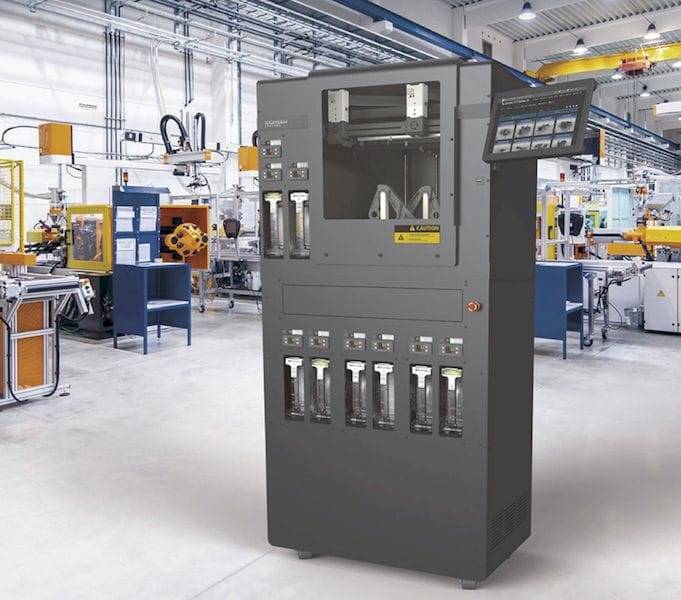[ihc-hide-content ihc_mb_type=”show” ihc_mb_who=”reg” ihc_mb_template=”3″ ]
[vc_row][vc_column][vc_column_text]Credit – www.fabbaloo.com
This is by no means a desktop 3D printer, but is in fact a large, 102kg device suitable for use in workshops and manufacturing floors. It includes a number of advanced features that are tuned for manufacturing quality and efficiency, with particular attention paid to its ability to 3D print a wide variety of engineering materials.
The X1S includes a very generous build volume of 295 x 295 x 305 mm, but the key feature of the system is its unusual extrusion system.
The X1S is equipped with dual extruders set up for independent motion; each extruder can operate simultaneously and in different directions than the other. In addition to the normal dual-extrusion capabilities of multiple materials and dissolvable support structures, this opens up the possibility of more sophisticated print modes, including:
- Dual printing, where two copies of the same object are produced in the same job in the time it would normally take to produce one.Mirror printing, where two copies of the object are produced, but with a reversed X axis. For example, two identical left and right housings could be made at the same time.
- Single/Dual printing, where a single object is produced at faster speed by two extruders simultaneously working on different segments.
Xioneer has also provided a powerful nozzle swapping system in the X1S Industrial. Rather than employing the more typical “screw in” nozzle approach that other vendors use, Xioneer has produced something they call a “Nozzle Unit”. They explain:
“Our nozzle units can be switched within minutes to adapt quickly to your actual printing needs. They are currently available in the options Standard, Fine, Hard, and Bold. The system recognizes automatically whether the current nozzle unit is suitable for the inserted material as well as for the upcoming print job. The integrated usage indicator helps to monitor its usage; thus increasing reliability through preemptive maintenance.”
These four Nozzle Units have different characteristics:
- STANDARD: “Allrounder”, has a special coating for consistent material flow and high reliability
- FINE: “For Finest Details’, has a specially formed nozzle tip for printing fine details
- BOLD: “For Highest Speed”, has a high material throughput for fast prints
- HARD: “For Toughest Parts”, has an abrasive-resistant ceramic nozzle for printing fiber-reinforced materials
The nozzles permit layer deposition of between 0.05 and 0.50mm. The latter figure is quite coarse and should allow for more rapid printing.
3D printer operators tend to not swap nozzles often because of the effort required to do so, and the possibility of damaging the machine. With the introduction of “Nozzle Units”, it may be that Xioneer will encourage more use of nozzle swapping.
Another interesting twist is the ability to mix these nozzle units within a print job, because there are two nozzles required. For example, you could use a coarse and a fine nozzle at the same time, presenting some unusual printing opportunities. However, I am not sure if the software is up to the task of generating GCODE for such scenarios.
By the way, the X1S is bundled with Simplify3D slicing and management software.
The X1S Industrial also includes some interesting material handling features. The machine requires use of special “plug and play cartridges”, which are presumably only available from Xioneer. In the past (and some current machines) this approach was used by some 3D printer manufacturers to ensure material sales were solely from that manufacturer.
This is likely true with Xioneer as well, but they also provide some very useful value through these cartridges. They explain:
“The Xioneer X1s Industrial automatically feeds the filament from the cartridge, verifies material parameters, and informs you whether the amount of material suffices for the print job. Achieve perfect printing results with hygroscopic materials like Nylon or water-soluble support materials using the integrated material drying units.”
These are all quality-improving features, in particular the material matching capability, which will surely prevent very common operator errors. Similarly, the automatic loading feature should cut down the mistakes.
I’m also very interested int the integrated drying units, which may be unique among 3D printer material handling cartridges. According to the specifications, the drying units can run at 60C, which is sufficient to restore almost any common filament material to a good state.
Even though the build chamber on the X1S Industrial can be heated to 70C, the hot ends on the X1S Industrial are not considered to be high temperature, as the device is capable of 3D printing more common materials, such as ABS, ASA, PC, PETG, Nylons and TPU. If you’re interested in 3D printing PEEK, ULTEM, PAEK and similar high-temperature materials, you will have to seek another device.
But then, perhaps Xioneer is working on a high-temperature version of the X1S?[/vc_column_text][/vc_column][/vc_row]
[/ihc-hide-content]
The AM Chronicle Editorial Team is a collective of passionate individuals committed to delivering insightful, accurate and engaging stories to additive manufacturing audiences worldwide.



